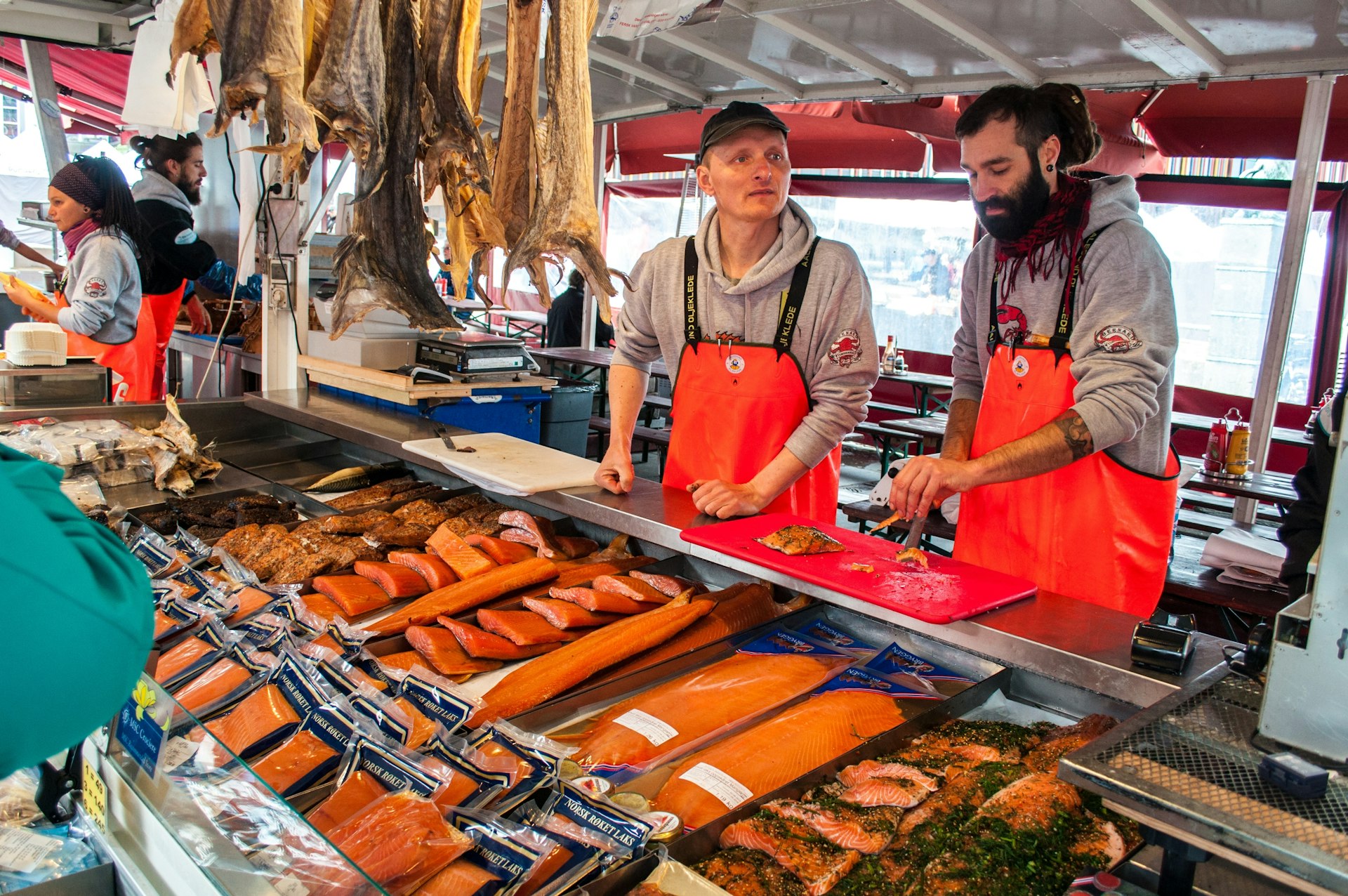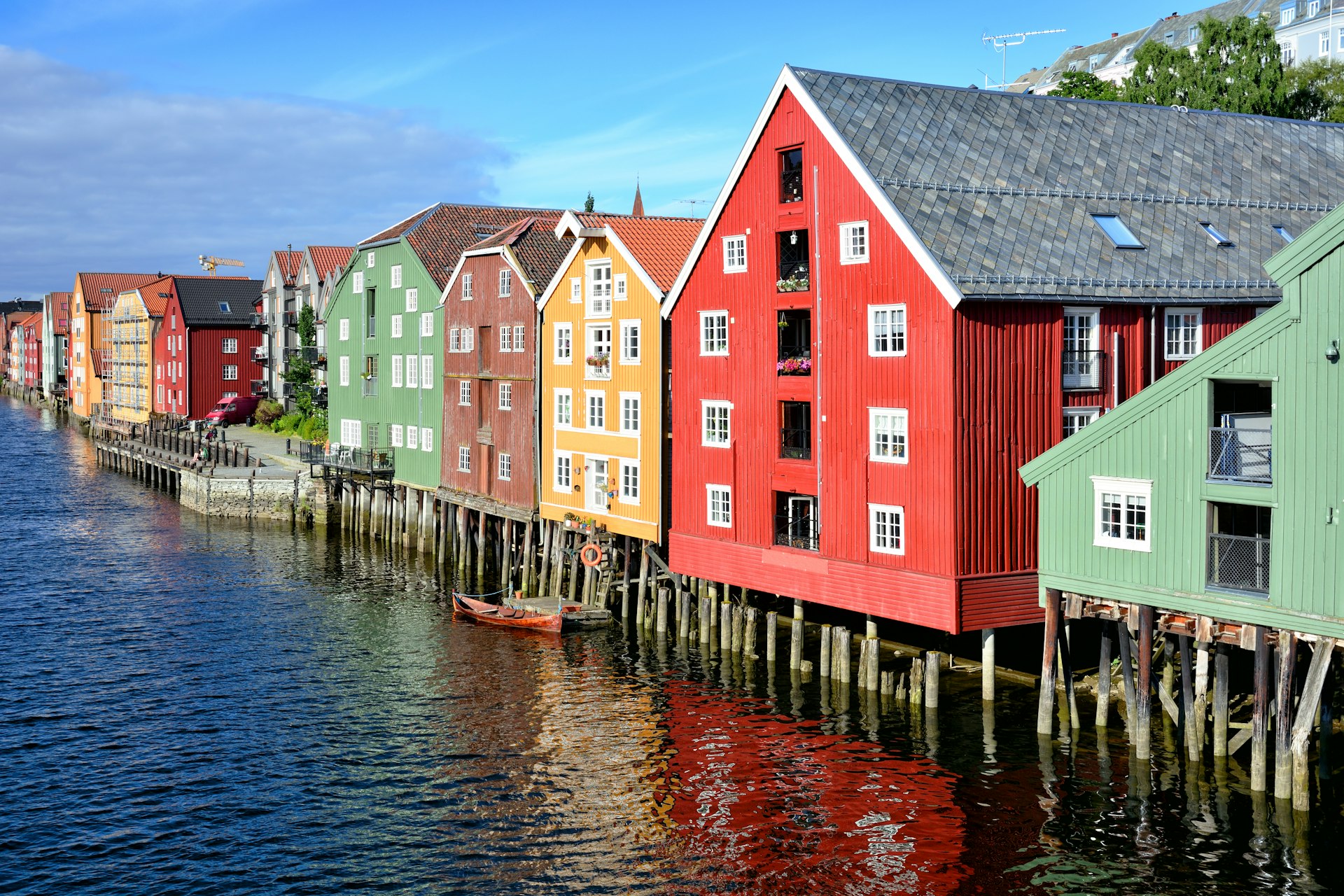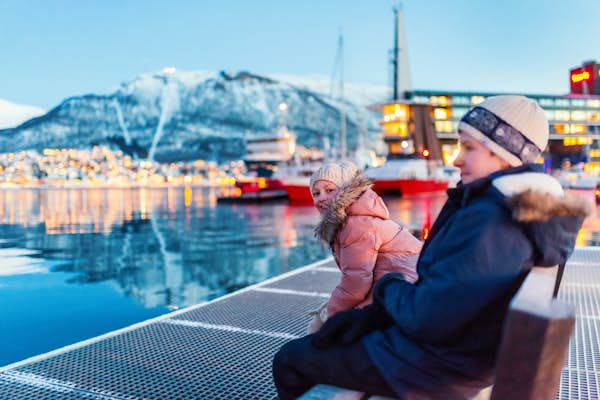In short, Norway is amazing. Along the west coast, shimmering blue fjords carve deep inland, picture-perfect villages hug the coast and gravity-defying farms cling to the steep slopes above. In other regions, the coastline is less dramatic, but still stunning with whitewashed towns and countless islands. Meanwhile, Norway’s interior is home to some of Europe’s wildest and most beautiful mountains, dotted with green agricultural valleys and dense forests.
Almost everywhere you go in Norway, you’ll find breathtaking scenery and plenty of inspiring activities. Here are the best places to visit in 2024.
 The iconic National Opera House rises along Oslo’s harbor © Nanisimova / Shutterstock
The iconic National Opera House rises along Oslo’s harbor © Nanisimova / Shutterstock
1. Oslo
Perfect for museums and architecture
Norway’s energetic and innovative capital boasts a top-notch historical and cultural museum, a creative gastronomic scene, and cutting-edge architecture, including the impressive new Munch Museum and the iconic Opera House, designed to resemble a glacier. I’m proud. Take a stroll along the new waterfront promenade and get a close-up view of Oslo’s evolving cityscape. After a year of renovation work, the Nobel Peace Center reopened in November 2023.
Planning tip: While the Viking Ship Museum, one of Oslo’s top attractions, is closed until 2026, the Fram Museum is another ship-centered museum that tells the fascinating story of Norwegian polar exploration. It’s a great tourist attraction.
2. Lofoten Islands
Perfect for stunning arctic beauty
The Lofoten Islands are vibrant, dramatic and irresistibly photogenic, with jagged mountains rising out of the sea and colorful villages surrounding rocky coasts that are covered in moss green in summer and snow-white in winter. Come enjoy the hiking, kayaking, art scene, history, wildlife, seafood, or just to admire the stunning scenery of Norway’s northern fringes. In the summer, there is almost endless sunlight, and in the winter, the Northern Lights twinkle overhead in waves of green, yellow, red, and purple.
 You can base yourself in a lodge or go wild camping in Jotunheimen National Park © Philartphace / Getty Images
You can base yourself in a lodge or go wild camping in Jotunheimen National Park © Philartphace / Getty Images
3. Jotunheimen
Perfect for hiking and trekking
Home to 29 of Norway’s highest peaks, as well as hundreds of other peaks over 2,000 meters above sea level, Jotunheimen (its name means “home of the giants”) is rugged, wild and appealing to hikers and mountaineers. It’s a charm. You can base yourself in a mountain lodge or cabin and go on a day hike, or embark on a multi-day trek through the wilderness through unparalleled scenery. Much of this area is protected within the Jotunheimen National Park and is easily accessible from the fjord region and several cities.
Planning tip: Join the Norwegian Trekking Association (DNT) and get discounts and special access to a large network of manned lodges and unmanned cabins across Norway, including many in and around Jotunheimen.
4. Sognefjord
Perfect for stave churches and beautiful fjordside villages
The longest and deepest fjord, Sognefjord, cuts inland from the west coast to the edge of Jotunheimen. It is home to many scenic areas, including the beautiful Aurlandsfjord and Nærøyfjord, both UNESCO World Heritage Sites. Some of Norway’s 28 surviving medieval stave churches are located around the Sognefjord, including two of the most impressive, Urneskirche and Borgundkirche. There are also picturesque villages surrounding the fjord, such as the book town of Fjälland. Idyllic Sorborn. Undredal is known for its goat cheese. and Flåm, the lower terminus of the scenic Flåm Railway.
Planning tip: UNESCO fjord sightseeing cruises operate between Flåm and Gudvangen, with a transfer to a bus to complete the round trip. If you are traveling by car, you also have the option of taking the car ferry between Kaupanger and Gudvangen.
5. Hardangerfjord
Perfect for waterfalls and cider
Hardangerfjord, Norway’s second longest fjord, is known for its orchards and many spectacular waterfalls. There’s no limit to what you can do here, from kayaking in quiet coves to biking trails along fjords, hiking to the remote Kiesøsen farm, and trekking to the glaciers of Folgefonna National Park. Hardangerfjord is beautiful at any time of the year, but it takes on even more beauty from mid-May to mid-June when the region’s many apple and cherry trees bloom. While you’re here, be sure to try some of the locally produced ciders and juices.
Planning tip: Norred’s high-speed passenger ferry operates from April to October, allowing you to travel between destinations around Hardangerfjord without a car. There are also several car ferries that you can walk to and board for free.
 Sample Bergen’s amazing fresh fish available at the market © Jan Zabrodsky / Shutterstock
Sample Bergen’s amazing fresh fish available at the market © Jan Zabrodsky / Shutterstock
6. Bergen
The best mix of urban charm and outdoor recreation
Norway’s second-largest city is home to the UNESCO World Heritage-listed waterfront district of Bryggen. Bryggen is a delightful district of colorful wooden buildings and narrow alleys that was once home to the powerful medieval Hanseatic merchants. Although Bergen is surrounded by mountains and has great hiking trails that are easily accessible, it is very much a maritime city, as reflected in its vibrant restaurant scene with fresh fish and seafood.
Planning Tip: The Bergen Card provides free or discounted admission to Bergen’s many great museums and other attractions, as well as tours and transportation.
 Enjoy spectacular views on a ferry across the Geirangerfjord © Marco Wong / Getty Images
Enjoy spectacular views on a ferry across the Geirangerfjord © Marco Wong / Getty Images
7. Geiranger
Perfect for panoramic views of the fjord
Geirangerfjord, a UNESCO World Heritage Site, is one of Norway’s most beautiful fjords, with sheer walls, impressive waterfalls, and abandoned farms clinging to high cliffs. The ferry journey between Geiranger and the quiet village of Helleschild takes you overland to Geiranger from the north on Route 63, Ornewegen (Eagle Road), winding around the mountainside and around its 11 hairpin bends. It’s great, as is the route you connect with. Stop at the highest switchback, Ohneswingen, for panoramic views.
Planning Tip: East of Geiranger, Route 63 follows the northern side of the Glacier Massif. From Jupevatn (surcharge), take a side road to Dalsnibba Lookout, which offers great views towards Geiranger.
8. Ålesund
Perfect for early 20th century architecture and design
Regularly voted one of Norway’s most beautiful cities, Ålesund gained its special character thanks to a devastating fire that burned down the town in 1904, leaving 10,000 people homeless. When the city rose from the ashes, it was a completely new urban landscape in the Jugendstil (Art Nouveau) style, unique in Norway. To enjoy Ålesund’s unparalleled panorama and its magnificent natural surroundings, climb the 418 steps to the Aksula Viewpoint, which overlooks the city centre.
 Colorful houses line the Nidelva River in Trondheim’s Old Town © Getty Images
Colorful houses line the Nidelva River in Trondheim’s Old Town © Getty Images
9. Trondheim
The best blend of history and innovation
Trondheim, Norway’s historic Viking capital, has much to offer, including a vibrant university town, medieval pilgrimage site, center of science and technology, and gastronomic hotspot (last year it was European Gastronomic Capital). there is. The Niderva River flows through the city center and is lined with colorful warehouses. Rent a kayak or take a sightseeing tour by boat to enjoy the best views. Trondheim’s main attraction is Nidaros Cathedral, a medieval masterpiece built over the tomb of Norway’s patron saint, King Olaf II Haraldsson. His 17th-century Christiansten fortress across the river played an important defensive role during the Scandinavian wars until it was captured by the Nazis. During World War II.
10. Nordland Coast
Ideal for road trips along the natural coastline
In a country where spectacular scenery is everywhere, Kistrixveien, the coastal road from Steinkjær to Bodø (European Capital of Culture in 2024) stands out, with mountains rising from the sea, sandy coves, picturesque fishing villages and birdwatching. numerous islands, including the hotspots of Vega and Lobundo. The entire route is 400 miles (650 km) and takes a minimum of 4 to 5 days by car, with several ferries and many worthwhile detours along the way. Kystriksveien is also a great cycling destination. Guided tours and luggage transport are also available.
Planning tip: Ferries on the route use the AutoPass system for billing. If you do not have a transponder, register for an account in the FerryPay system to avoid additional charges for mailing your invoice. For more information, please visit www.autopassferje.no.
 Travel north of the Arctic Circle and arrive in the city of Tromsø © V. Belov / Shutterstock
Travel north of the Arctic Circle and arrive in the city of Tromsø © V. Belov / Shutterstock
11. Tromsø
The perfect city for year-round outdoor activities
Located 315 km (217 miles) north of the Arctic Circle, Tromsø is the largest city and unofficial capital of northern Norway. In the summer, you can hike, kayak, sauna hop, and enjoy city fun under the midnight sun. Winter, on the other hand, offers great opportunities to ski, snowshoe, dog sled and reindeer while seeing the magical glow of the Northern Lights overhead. Ride a sled through the pristine winter landscape. Winter is also a great time for whale watching, and summer is the perfect time for birdwatching cruises to look for puffins and other seabirds.
Local Tip: Since 2001, Tromsø has partnered with Gaza City, and this topic is currently hotly debated among locals.
12. Svalbard
Ideal for remote areas and arctic wildlife
Isn’t Tromsø too far north? Next, head to Svalbard, an Arctic archipelago located approximately halfway between mainland Norway and the North Pole. Norwegians, Russians and other nationals all live in Svalbard within the visa-free zone. During the polar summer, the islands are crowded with migratory birds such as whales and seabirds. Polar bears and reindeer roam here year-round, and seals and walruses are often seen hauled up on the ice floes and the island’s shores. In winter, a long polar night falls on the archipelago, and the only natural light comes from the moon, stars, and the vivid aurora borealis that frequently dance across the sky.
Planning tip: Longyearbyen, the administrative center of Svalbard, has a small but impressive range of restaurants, making it the perfect place to get a taste of the Arctic.

